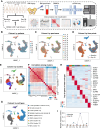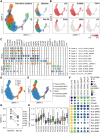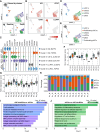Reconstitution of the Multiple Myeloma Microenvironment Following Lymphodepletion with BCMA CAR-T Therapy
- PMID: 39024031
- PMCID: PMC11393544
- DOI: 10.1158/1078-0432.CCR-24-0352
Reconstitution of the Multiple Myeloma Microenvironment Following Lymphodepletion with BCMA CAR-T Therapy
Abstract
Purpose: The purpose of this study was to investigate the remodeling of the multiple myeloma microenvironment after B-cell maturation antigen (BCMA)-targeted chimeric antigen receptor T (CAR-T) cell therapy.
Experimental design: We performed single-cell RNA sequencing on paired bone marrow specimens (n = 14) from seven patients with multiple myeloma before (i.e., baseline, "day -4") and after (i.e., "day 28") lymphodepleted BCMA CAR-T cell therapy.
Results: Our analysis revealed heterogeneity in gene expression profiles among multiple myeloma cells, even those harboring the same cytogenetic abnormalities. The best overall responses of patients over the 15-month follow-up are positively correlated with the abundance and targeted cytotoxic activity of CD8+ effector CAR-T cells on day 28 after CAR-T cell infusion. Additionally, favorable responses are associated with attenuated immunosuppression mediated by regulatory T cells, enhanced CD8+ effector T-cell cytotoxic activity, and elevated type 1 conventional dendritic cell (DC) antigen presentation ability. DC re-clustering inferred intramedullary-originated type 3 conventional DCs with extramedullary migration. Cell-cell communication network analysis indicated that BCMA CAR-T therapy mitigates BAFF/GALECTIN/MK pathway-mediated immunosuppression and activates MIF pathway-mediated anti-multiple myeloma immunity.
Conclusions: Our study sheds light on multiple myeloma microenvironment dynamics after BCMA CAR-T therapy, offering clues for predicting treatment responsivity.
©2024 The Authors; Published by the American Association for Cancer Research.
Conflict of interest statement
No disclosures were reported.
Figures






References
-
- Kumar SK, Rajkumar V, Kyle RA, van Duin M, Sonneveld P, Mateos MV, et al. . Multiple myeloma. Nat Rev Dis Primers 2017;3:17046. - PubMed
-
- van de Donk NWCJ, Pawlyn C, Yong KL. Multiple myeloma. Lancet 2021;397:410–27. - PubMed
-
- Mikkilineni L, Kochenderfer JN. CAR T cell therapies for patients with multiple myeloma. Nat Rev Clin Oncol 2021;18:71–84. - PubMed
-
- van de Donk NWCJ, Usmani SZ, Yong K. CAR T-cell therapy for multiple myeloma: state of the art and prospects. Lancet Haematol 2021;8:e446–61. - PubMed
-
- Berdeja JG, Madduri D, Usmani SZ, Jakubowiak A, Agha M, Cohen AD, et al. . Ciltacabtagene autoleucel, a B-cell maturation antigen-directed chimeric antigen receptor T-cell therapy in patients with relapsed or refractory multiple myeloma (CARTITUDE-1): a phase 1b/2 open-label study. Lancet 2021;398:314–24. - PubMed
MeSH terms
Substances
Grants and funding
- Z200020/Natural Science Foundation of Beijing Municipality (Beijing Natural Science Foundation)
- 2021YFA1300603/Ministry of Science and Technology of the People's Republic of China (MOST)
- 32350020/National Natural Science Foundation of China (NSFC)
- 82188102/National Natural Science Foundation of China (NSFC)
- BJ-2022-127/National High Level Hospital Clinical Research Funding
LinkOut - more resources
Full Text Sources
Medical
Research Materials
Miscellaneous

